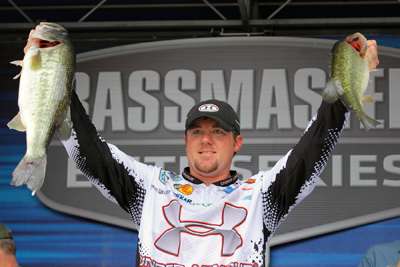
The success of flipping and pitching specialists in the Bassmaster Elite Series could lead an angler to stereotype the old reliable jig-and-chunk combo as a shallow water bait.
However the Elite Series pros know this combo can be just as effective on a long delivery to probe the depths as it is in thin water. Carolina rigging with soft plastics or Texas rigging a plastic worm catches plenty of deep bass in the summertime, but a jig is Jason Williamson’s choice when he fishes deep along offshore structure.
“You have more options with a jig and you get bigger bites,” says the South Carolina pro. “You can fish it real slow along the bottom or if the fish are suspended you can stroke it to get a reaction strike. “I can also play with the different chunk trailers. If it gets real hot, I will throw a smaller chunk. If I am fishing a jig real slow, I like a little bit bigger trailer such as the Zoom Super Chunk. When I am stroking a jig or working it real fast I will either use a Zoom Pro Chunk or a Zoom Fat Albert Twin Tail.”
Whenever he wants to work a jig fast for aggressive fish, Williamson opts for a 1-ounce football jig that he strokes or hops vigorously along the bottom.
If this tactic fails to produce, Williamson relies on a 1/2-ounce Buckeye Lures Mop Jig, a conventional-style jig that he can work slower along the bottom. He prefers this jig because it has large rubber strands that generate more action than silicone skirts and make the lure more buoyant than a football jig. “The way the rubber is hand-tied makes the jig skirt flare in and out without me moving the line or the rod while it sits on the bottom,” he says.
The two-time BASS winner opts for a brown, brown-and-orange or brown-and-black Mop Jig that he combines with a green pumpkin Zoom Super Chunk for his slow deep-water presentation. He modifies the combo by unevenly trimming the jig’s skirt to give it a “rugged look” and adding two rattles to the jig. The Mop Jig works best for Williamson when he works it over rocks along points and humps associated with creek channels.
The location of the creek channel is the key to fishing this offshore structure with a jig. “When I pull up on the spot, I use my electronics to find the creek channel side of it and make numerous casts to it,” he says. “Long casts are very important when you are fishing offshore structure deep in the summer.”
Williamson positions his boat over depths of 20 to 25 feet and casts as far as he can to make his lure land in the 8- to 10-foot depth range. When his jig hits the bottom, Williams lowers his rod to a 45-degree angle so he can hop and drag the lure. “I move it real slow with real short hops and then I drag it a little bit,” describes Williamson. “Then I reel in my slack while I let it sit there a second, and then I repeat the motion with a couple of short hops and just drag it a little bit again.”
Jig bites in deep water are usually subtle. “A lot of times you will go to hop it or drag it and your line will feel mushy or heavy, and you will fee the fish swimming off with it,” says Williamson. “Other times the fish will hit and knock slack in your line because the fish is swimming toward you.” A hard hook set is required since the jig is usually a long distance from the boat when the strike occurs. “I try to come straight up with my rod and reel pretty hard,” says Williamson, who employs a Bass Pro Shops Johnny Morris Gold Series baitcast reel with a 7.1:1 gear ratio for winding quickly during the hook set.
He spools his reel with 20-pound McCoy Fluorocarbon 100 line and matches it with a 7 1/2-foot Duckett Fishing Micro Magic extra-heavy action rod for his deep jig tactics. Editor’s Note: If you have a story idea you would like to vote on for an upcoming poll, send your idea to john@jnoutdoors.com.





